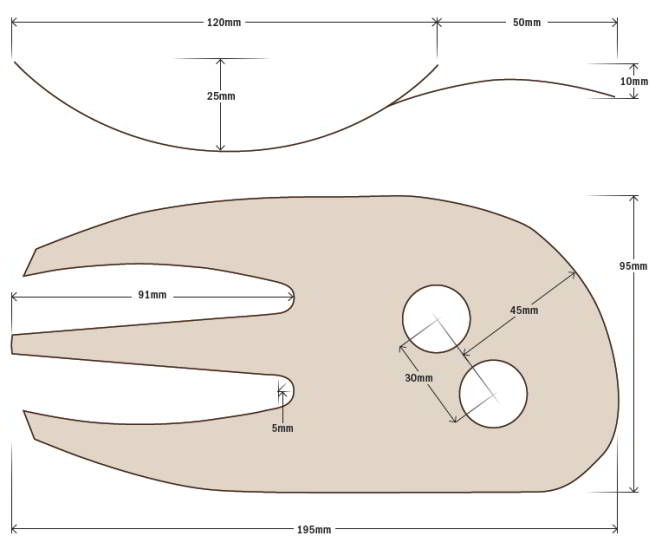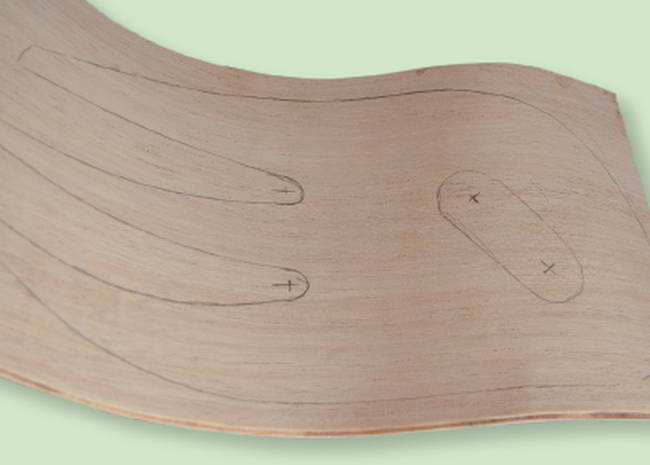These salad fingers are reasonably easy to make and are a great gift.
The diagram (below) opposite shows the profile I’ve used for laminating veneers for these servers. I cut three silver ash veneers of about 1.3mm each and found that they can bend to this curve without having to apply any heat, which keeps things simple.
The final thickness was just over 4mm which was quite rigid without being cumbersome. Choose a medium density hardwood to reduce absorption of moisture while having the flexibility to bend to this curve.

Making the cauls
The first step is to prepare cauls to this shape. I used a 300 x 125 x 60mm block of wood that was reasonably easy to work. Mark the profile on the side and cut along it with a bandsaw. I have a 14mm blade that was just able to follow this curve. Clean up the cut, making sure the surfaces are square to the sides and parallel when placed 4mm apart.
I’ve found that the curvature of the cauls prevents the veneers from slipping over each other as they are clamped which in turn leads to poor bonding across the fingers. The solution is to cut the top caul in half and then clamp one end first. I added two dowels to ensure accurate alignment of the cauls as the veneers are clamped together.
Cut the veneers
In AWR#64 Darren Oates described a number of resawing jigs that will help cut the veneers required here. I have a homemade featherboard and fence that work well also.
Make sure that the blade is clean and tensioned and set up the fence for about a 2mm cut. Resurface the board after each cut so that one side of each veneer will be clean.

Above: Bandsawing the required veneersfrom a board of silver ash using ahomemade featherboard and fence set-up for accurate and safe cutting.
I then reduced these veneers to 1.5mm in my thicknesser. To help with this, I inserted a 20mm board of melamine coated particleboard into the bottom of the thicknesser — this was to offset the base from the cutters and to reduce friction.
The only problem I encountered was with some figure on a veneer where the grain wasn’t straight. I cleaned up the surfaces of these veneers with a hand plane by clamping one edge while I planed the other half. Sanding would work as well.

Above: The bandsawn 2mm veneers were thicknessed to 1.5mm using a sheet of melamine to offset the base from the cutters
Test the bend
Test whether your veneers will bend to the curve in the cauls and keep reducing the thickness until it will bend without cracking. I found that silver ash veneer of 1.3mm will bend to this curve reasonably though I suspect that this will vary with other hardwoods.
Pre-cut veneers are an alternative that could work well. You may need more layers if they are thinner.
Glue-up
The glue-up is straightforward. I used Titebond III as it claims to be both waterproof and food safe, and I used plastic film to keep the glue off the mould.
Insert the veneer and clamp one end of the caul, then insert and clamp the other end. When I released the veneer after 24 hours drying time, it relaxed by about 1mm which I thought was acceptable.


Above: Glue was rolled onto the veneer sections prior to applying even clamping pressure. Plastic film kept the glue off the cauls.
Cut the finger shapes
Draw up a template for the shape you prefer or use the diagram above. Transfer this template to cardboard or plastic and
then mark this shape onto the laminated veneers. I cut the rounds for the tops of the fingers and the fingerholds using forstner bits.

The shape marked out on the laminated veneer prior to cutting.
To avoid tear-out, I came in from both sides. I cut the rest of the profile with a jigsaw mounted upside down in a vice and then sanded the edges.
Oil finish
There are a range of options for a foodsafe finish for your salad fingers. Oil/varnish and wiping varnishes should be used sparingly as any surface build up will be difficult to repair when the surface film eventually breaks down. Boiled linseed and tung oils are good choices as they are both curing oils and will slowly harden. It is quite likely also, that you could get many years of service from your servers with nothing more than a sanded finish.
Remember that timber items like this are not dishwasher safe. Provided you don’t leave them standing in water, a mild scrub using normal dishwashing liquid should be fine.
Photos: Iain Green
First published in Australian Wood Review magazine, issue 67.










